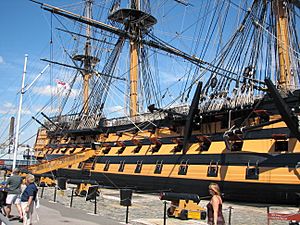Nelson Chequer facts for kids
The Nelson Chequer was a special paint design used on ships of the Royal Navy. It was inspired by Admiral Horatio Nelson and how he painted his ships for battle. This design featured stripes of black and yellow paint along the sides of the ship. When the gunports (openings for cannons) were closed, the ship looked striped. But when the gunports were open, they showed black, making the ship look like a checkerboard.
Contents
Why Ships Had Different Colors
For a long time, in the 1700s and 1800s, ships from different countries were painted in many different colors. Each ship's captain could choose how to paint their vessel. This helped people tell ships apart during a battle.
The Royal Navy tried to make all its ships look the same sometimes. In 1715, an order from the Admiralty (the group in charge of the navy) said ships should use yellow and black. But most captains didn't follow this rule. Later, in 1780, the Admiralty gave another order. This one allowed captains to paint their ships in either yellow or black.
Nelson's Special Design
Admiral Nelson really liked the yellow color with black stripes. He also had the inside of his gunports painted black. This was a clever idea! When the gunports were closed, the ship looked like it had yellow and black stripes. But when the gunports were opened for a fight, the black insides showed. This made the ship look like a checkerboard pattern.
This "chequered" look was a signal. If a ship was sailing into a friendly harbor that had defenses, not showing the checkerboard meant "we are friendly."
Nelson used this same style for all the ships he commanded. He said it helped his ships "be distinguished with greater certainty" if they met an enemy. After the famous Battle of Trafalgar in 1805, Nelson's paint scheme became very popular. Most big ships in the Royal Navy started using this pattern. It wasn't a strict rule, though, and some captains still changed it. The Nelson Chequer style became less common after 1815. Around that time, white paint started to replace the yellow color.
HMS Victory Today
Nelson's most famous ship, HMS Victory, still has these colors today. You can see the yellow stripes along the gunports. The ship was painted this way during a repair in 1800 at Chatham.
Even though Nelson wanted his ships to stand out, other navies also used similar colors. Some ships of the United States Navy had a similar look. As the Napoleonic Wars ended, a new trend began. White paint started to be used instead of yellow. This became very popular with the United States Navy. They used black and white during the War of 1812.
Ships were often made of oiled wood, except for the wale. The wale was the widest part of the ship's side that rubbed against other ships or docks. These wales were usually blackened with tar. Over time, even with new oil, the wooden planks of a ship would get darker. This could sometimes show how old a ship was in a fleet. Later, paints like ochre or buff started to replace oil for the upper parts of the ship. This made all ships look more uniform. Also, the black wales became larger.
The USS Constitution was painted black and buff when it was launched in 1798. It kept those colors until the early part of the War of 1812. Only later in that war, when white paint became easier to find and cheaper, did it get its famous black and white look.
See also
- Dazzle camouflage, a different type of naval paint scheme from the 20th century
- Hull (watercraft)
- Invasion stripes, a pattern used on aircraft in the Second World War for identification



